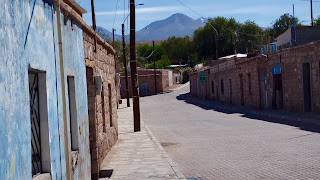Friday, 26 October 2018
Oases and Salt Lakes
There are still many communities in the Atacama desert that practice their traditional farming techniques from pre-Colombian times in oases. We visited one where there is a river running through a canyon (I think the water appears and disappears underground on either side of the village). They have an extensive network of small channels that they use to flood irrigate their fields in rotation every 15 to 20 days.
The village is very close to the Andes, and they visit the lake at the top of the local volcano once a year to give thanks for the clear fresh water.
All the houses are built together and they appear very parched as the streets are all brick and the houses are right on the street.
We walked through the desert around the village and the fields and noticed the poplars and other large trees they grow. The desert stops at a wall, or one side of the river bank, and the plants are prolific inches away.
Each field is surrounded by brush walls and separated from the paths with gates but the tree branches cover most of the paths making them a lot cooler.
They use many of the crops we are used to - persimmons and pears formed the top story in the garden we were shown, with apricots forming a lower story and herbs like mint, parsley, and leafy green vegetables forming the ground cover.
We left that village and drove to another at the foot of another mountain of the Andes. This village was in a wetter area, where some grass grows, but without an oasis. The farms were dotted around, and each field was in a valley where the water was channeled to make a wetter area.
After we left the villages, we went back down into the desert to the salt lakes where pink flamingos live.
We stopped To see the museum with a collection of pre-Colombian artifacts including very old textiles. Although the collection was very small, it was stunning.
Subscribe to:
Post Comments (Atom)

















No comments:
Post a Comment